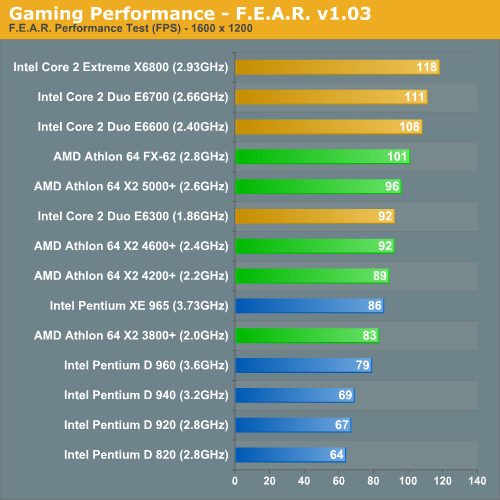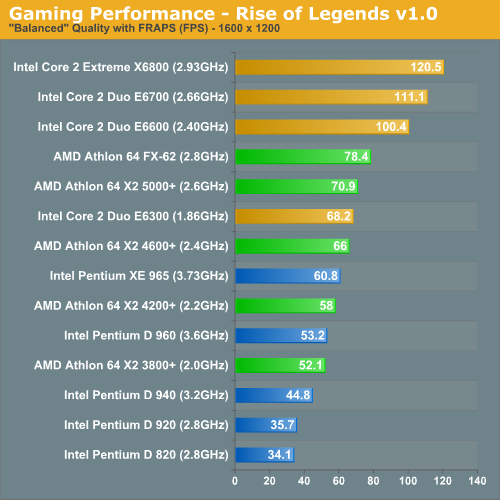Intel's Core 2 Extreme & Core 2 Duo: The Empire Strikes Back
by Anand Lal Shimpi on July 14, 2006 12:00 AM EST- Posted in
- CPUs
Gaming Performance using F.E.A.R. & Rise of Legends
Our F.E.A.R. test should be fairly familiar by now, as it is the built in performance test included with the game. Computer settings were left at "Maximum" while the graphics settings were set to "High" with the resolution cranked up to 1600 x 1200. F.E.A.R. ends up still being more GPU than CPU bound at these settings, even with a pair of X1900 XTs at its disposal, but we do see some separation among the processors:

The top three spots still go to the top three Core 2 CPUs, with the E6300 falling around the level of the X2 4600+. A trend that we've been seeing all throughout this review is that the performance of these CPUs effectively falls into three groups: Core 2 processors at the top, Athlon 64 X2s in the middle and Pentium D at the very bottom of the charts. In a sense that's the easiest way to classify these three groups of processors: if you want the fastest it's Core 2, mid-range goes to the Athlon 64 X2 and if you don't like good performance there's always the Pentium D.
Rise of Legends is a newcomer to our game benchmark suite and what an excellent addition it is. This Real Time Strategy game looks very good and plays well too; it serves as good filler until the next Command & Conquer title eventually arrives for those looking for a RTS fix. We ran with the resolution set to 1600 x 1200 and the graphics settings set to the medium defaults. We recorded a custom playback of a 3 vs. 2 multiplayer battle and played it back at 4x speed, recording the average frame rate for 10 minutes of the battle. The 10 minutes we focused on contained a good mix of light skirmishes between opponents, base/resource management with very few characters on the screen and of course some very large scale battles.

As with most RTSes, Rise of Legends is extremely CPU bound. The performance variability between runs was fairly high in this test, mainly because of how disk intensive the playback can get. Differences in performance of up to 5% should be ignored, but the standings are correct - the Core 2 line of processors absolutely demolish the competition: you're looking at true next-generation CPU performance here. The E6300 isn't nearly as impressive when compared to its more expensive siblings, but when you compare it to AMD's lineup it looks very good, especially considering its proposed cost.










202 Comments
View All Comments
coldpower27 - Friday, July 14, 2006 - link
Are there supposed to be there as they aren't functioning in Firefox 1.5.0.4coldpower27 - Friday, July 14, 2006 - link
You guys fixed it awesome.Orbs - Friday, July 14, 2006 - link
On "The Test" page (I think page 2), you write:please look back at the following articles:
But then there are no links to the articles.
Anyway, Anand, great report! Very detailed with tons of benchmarks using a very interesting gaming configuration, and this review was the second one I read (so it was up pretty quickly). Thanks for not saccrificing quality just to get it online first, and again, great article.
Makes me want a Conroe!
Calin - Friday, July 14, 2006 - link
Great article, and thanks for a well done job. Conroe is everything Intel marketing machine shown it to be.stepz - Friday, July 14, 2006 - link
The Core 2 doesn't have smaller emoty latency than K8. You're seeing the new advanced prefetcher in action. But don't just believe me, check with the SM2.0 author.Anand Lal Shimpi - Friday, July 14, 2006 - link
That's what Intel's explanation implied as well, when they are working well the prefetchers remove the need for an on-die memory controller so long as you have an unsaturated FSB. Inevitably there will be cases where AMD is still faster (from a pure latency perspective), but it's tough to say how frequently that will happen.Take care,
Anand
stepz - Friday, July 14, 2006 - link
Excuse me. You state "Intel's Core 2 processors now offer even quicker memory access than AMD's Athlon 64 X2, without resorting to an on-die memory controller.". That is COMPLETELY wrong and misleading. (see: http://www.aceshardware.com/forums/read_post.jsp?i...">http://www.aceshardware.com/forums/read_post.jsp?i... )It would be really nice from journalistic integrity point of view and all that, if you posted a correction or atleast silently changed the article to not be spreading incorrect information.
Oh... and you really should have smelt something fishy when a memory controller suddenly halves its latency by changing the requestor.
stepz - Friday, July 14, 2006 - link
To clarify. Yes the prefetching and espescially the speculative memory op reordering does wonders for realworld performance. But then let the real-world performance results speak for themselves. But please don't use broken synthetic tests. The advancements help to hide latency from applications that do real work. They don't reduce the actual latency of memory ops that that test was supposed to test. Given that the prefetcher figures out the access pattern of the latency test, the test is utterly meaningless in any context. The test doesn't do anything close to realworld, so if its main purpose is broken, it is utterly useless.JarredWalton - Friday, July 14, 2006 - link
Modified comments from a similar thread further down:Given that the prefetcher figures out the access pattern of the latency test, the test is utterly meaningless in any context."
That's only true if the prefetcher can't figure out access patterns for all other applications as well, and from the results I'm pretty sure it can. You have to remember, even with the memory latency of approximately 35 ns, that delay means the CPU now has about 100 cycles to go and find other stuff to do. At an instruction fetch rate of 4 instructions per cycle, that's a lot of untapped power. So, while it waits on main memory access one, it can be scanning the next accesses that are likely to take place and start queuing them up and priming the RAM. The net result is that you may never actually be able to measure latency higher than 35-40 ns or whatever.
The way I think of it is this: pipeline issues aside, a large portion of what allowed Athlon 64 to outperform NetBurst was reduced memory latency. Remember, Pentium 4 was easily able to outperform Athlon XP in the majority of benchmarks -- it just did so at higher clock speeds. (Don't *even* try to tell me that the Athlon XP 3200+ was as fast as a Pentium 4 3.2 GHz! LOL. The Athlon 64 3200+ on the other hand....) AMD boosted performance by about 25% by adding an integrated memory controller. Now Intel is faster at similar clock speeds, and although the 4-wide architectural design helps, not to mention 4MB shared L2, they almost certainly wouldn't be able to improve performance without improving memory latency -- not just in theory, but in actual practice. Looking at the benchmarks, I have to think that our memory latency scores are generally representative of what applications see.
If you have to engineer a synthetic application specifically to fool the advanced prefetcher and op reordering, what's the point? To demonstrate a "worst case" scenario that doesn't actually occur in practical use? In the end, memory latency is only one part of CPU/platform design. The Athlon FX-62 is 61.6% faster than the Pentium XE 965 in terms of latency, but that doesn't translate into a real world performance difference of anywhere near 60%. The X6800 is 19.3% faster in memory latency tests, and it comes out 10-35% faster in real world benchmarks, so again there's not an exact correlation. Latency is important to look at, but so is memory bandwidth and the rest of the architecture.
The proof is in the pudding, and right now the Core 2 pudding tastes very good. Nice design, Intel.
coldpower27 - Friday, July 14, 2006 - link
But why are you posting the Manchester core's die size?What about the Socket AM2 Windsor 2x512KB model which has a die size of 183mm2?